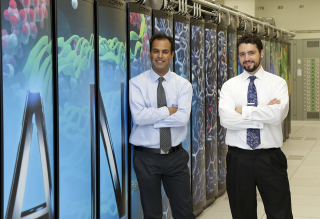Sep 3 2015
A set of automated calibration techniques for tuning residential and commercial building energy efficiency software models to match measured data is now available as an open source code. The Autotune code, developed at the Department of Energy's Oak Ridge National Laboratory, is available on GitHub.
 Automated calibration software for building efficiency studies, developed by Oak Ridge National Laboratory researchers Jibonananda Sanyal (left) and Joshua New, is now available as an open source code. Credit: ORNL
Automated calibration software for building efficiency studies, developed by Oak Ridge National Laboratory researchers Jibonananda Sanyal (left) and Joshua New, is now available as an open source code. Credit: ORNL
ORNL principal investigator Joshua New, in collaboration with a team of researchers, developed the automated calibration software, which reduces the amount of time and expertise needed to optimize building parameters for cost and energy savings.
By cheaply producing calibrated building energy models, Autotune allows “no-touch” audits, optimal retrofits and other simulation-informed applications to be cost-effectively realized for buildings traditionally too small (below 50,000 ft2) to be serviced by industry.
“The methodology uses multi-parameter optimization techniques, in combination with big data mining-informed artificial intelligence agents, to automatically modify software inputs so simulation output matches measured data,” New, a researcher in ORNL's Building Technologies Research and Integration Center, said.
“Instead of having a human change the knobs, so to speak, the Autotune methodology does that for you,” BTRIC researcher Jibonananda Sanyal said.
To develop their software, the team used DOE supercomputing and computational resources -- including ORNL’s Titan supercomputer and the National Institute for Computational Sciences’ Nautilus system -- to perform millions of EnergyPlus simulations for a range of standard building types with generated data totaling hundreds of terabytes. Titan resides in the ORNL Leadership Computing Facility, a DOE Office of Science User Facility.
By mining this data and trying many different calibration algorithms, the researchers were able to identify techniques and evolutionary computations that can quickly evolve a building to match measured data. On Titan, the team has been able to run annual energy simulations for more than half a million buildings and write 45 terabytes of simulation output to disk in less than one hour using over a third of Titan’s nearly 300,000 CPU cores in parallel.